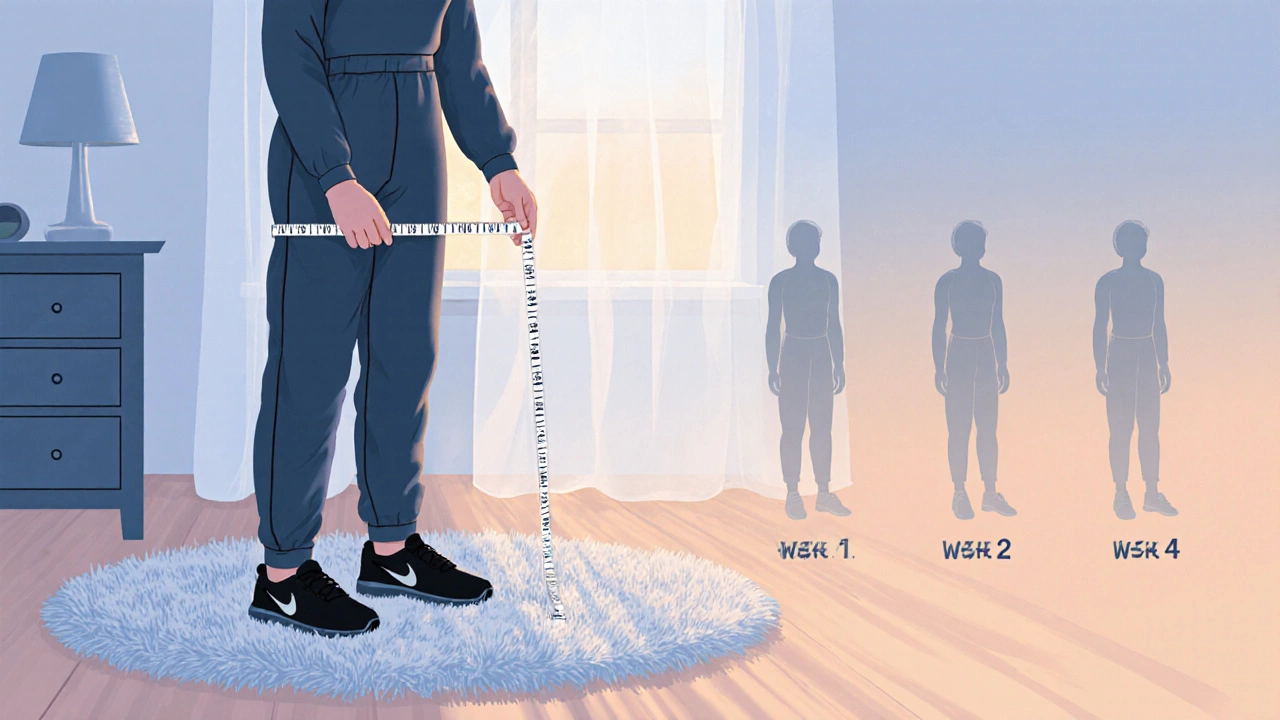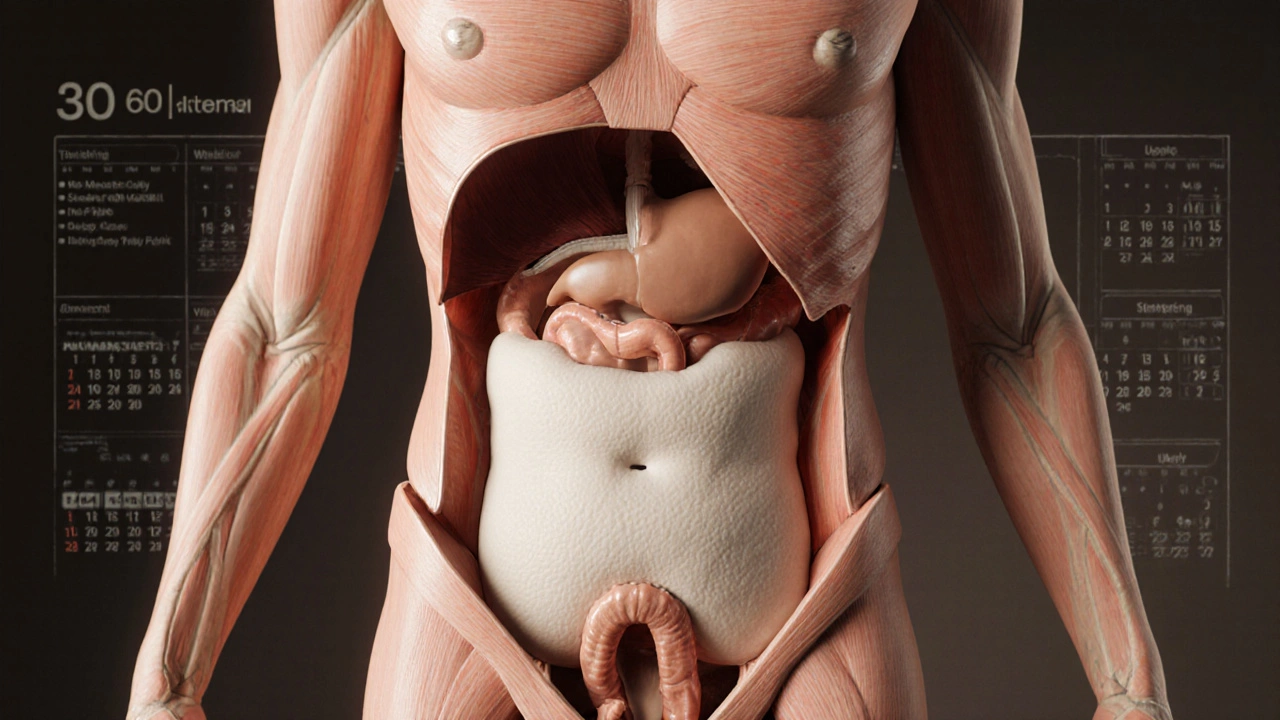Belly Fat Loss Calculator
Your Custom Plan
Your Results
Wondering if a month is enough to see a flatter stomach? The short answer is yes-if you combine the right nutrition, smart workouts, and lifestyle tweaks. But it’s not magic; it’s a series of small, science‑backed moves that add up. Below you’ll find a step‑by‑step guide that explains how belly fat works, what you can realistically expect in 30 days, and exactly what to do each week.
How Belly Fat Works
Belly fat is a term that covers both visceral and subcutaneous fat stored around the midsection. Visceral fat hugs internal organs and is linked to higher health risks, while subcutaneous fat sits just under the skin and is the softer layer you see in the mirror.
Both types store excess calories, but they respond differently to diet and exercise. Visceral fat burns faster when you create a calorie deficit, whereas subcutaneous fat tends to be more stubborn and often requires targeted strength work to reshape.
Realistic Expectations for a 30‑Day Sprint
Most people can drop 1-2 % of total body fat in a month with disciplined habits. That translates to roughly 0.5-1 kg (1-2 lb) of fat, and you’ll likely notice a slimmer waistline. The key is consistency-not a crash diet that leaves you drained after a week.
Rapid results are possible, but they come with trade‑offs: you may feel hungry, need more sleep, and have to manage stress carefully. If you respect those limits, the payoff is a noticeable reduction in belly circumference and a boost in confidence.
Core Strategies: Nutrition, Exercise, and Lifestyle
Three pillars drive belly fat loss in 30 days:
- Calorie deficit is the foundation-consume fewer calories than you burn.
- HIIT (high‑intensity interval training) spikes metabolism and targets visceral fat.
- Strength training builds muscle, raises resting metabolic rate, and helps reshape subcutaneous fat.
Layer these with good sleep, low stress, and balanced macronutrients (protein, carbs, fats) for sustained energy.
Nutrition Blueprint
1. **Calculate your daily needs** - Use a TDEE calculator and subtract 300‑500 kcal. This creates a sustainable deficit without triggering major hunger spikes.
2. **Prioritize protein** - Aim for 1.6‑2.2 g per kg of body weight. Protein protects muscle during a deficit and keeps you full longer.
3. **Choose fiber‑rich carbs** - Whole grains, legumes, and veggies add bulk without excess calories and improve gut health, which is linked to lower visceral fat.
4. **Add healthy fats** - Avocado, nuts, and olive oil support hormone balance, especially cortisol, which can drive belly fat storage when elevated.
5. **Limit added sugars and refined carbs** - These spike insulin, encouraging the body to store fat around the waist.

Exercise Blueprint
**HIIT Sessions (3× per week)**
- Warm‑up 5 min (light jog or jumping jacks).
- Perform 30 sec all‑out effort (e.g., sprint, burpees, kettlebell swings).
- Rest or low‑intensity movement for 90 sec.
- Repeat 8‑10 cycles, finish with a 5‑min cool‑down.
HIIT boosts EPOC (excess post‑exercise oxygen consumption), meaning you keep burning calories for hours after the workout.
**Strength Training (3× per week)**
- Focus on compound lifts: squats, deadlifts, bench press, rows.
- Work in the 8‑12 rep range for hypertrophy.
- Finish each session with a core circuit (planks, bicycle crunches, hanging leg raises) for functional stability, not spot‑reduction.
Lifestyle Tweaks that Matter
Sleep is a silent fat‑fighter. Aim for 7‑9 hours of quality sleep; lack of sleep raises ghrelin and cortisol, both of which can stall belly fat loss.
Manage stress with mindfulness, short walks, or breathing exercises. Chronic stress triggers cortisol release, which directs fat storage to the abdomen.
Stay hydrated-water aids digestion and can reduce false hunger signals.
Sample 30‑Day Plan
| Day | Nutrition Focus | Workout |
|---|---|---|
| Mon | Protein‑rich meals, fiber‑dense carbs | HIIT (20 min) |
| Tue | Maintain calorie deficit, add healthy fats | Strength (full body) |
| Wed | Low‑sugar day, high veg intake | Active recovery (walk or yoga) |
| Thu | Same as Mon | HIIT (20 min) |
| Fri | Protein focus, moderate carbs | Strength (full body) |
| Sat | Cheat‑smart: small treat, keep overall deficit | HIIT (20 min) or outdoor activity |
| Sun | Meal prep for next week, hydrate | Rest + stretch |
Rotate this schedule for four weeks, adjusting portion sizes if weight loss stalls.

Common Mistakes & How to Avoid Them
- Over‑cutting calories. Dropping below 1,200 kcal for most adults slows metabolism and can cause muscle loss.
- Relying on spot‑reduction. Doing endless crunches won’t melt belly fat; whole‑body fat loss is required.
- Skipping strength training. Without muscle, your resting metabolic rate drops, making the deficit harder to sustain.
- Ignoring sleep and stress. Even a perfect diet and workout plan can be undone by poor recovery.
Tracking Progress Wisely
Use a combination of methods:
- Measure waist circumference every 3‑4 days (same spot, same time).
- Take progress photos weekly-visual changes often appear before the scale moves.
- Log food with an app to ensure you stay within your calorie target.
- Record training intensity (RPE) to avoid over‑training.
If progress stalls after two weeks, tweak one variable: cut an extra 100 kcal, add a HIIT interval, or increase sleep by 30 minutes.
Quick FAQ
Can I lose belly fat without exercising?
Nutrition alone can create a deficit, but exercise accelerates visceral fat loss and preserves muscle, making results faster and more sustainable.
How much weight can I realistically lose in 30 days?
A safe rate is 0.5‑1 kg (1‑2 lb) of fat per week, so 2‑4 kg (4‑9 lb) in a month is typical if you stay consistent.
Do I need to count every macro?
Tracking protein and total calories is most critical. Fine‑tuning carbs and fats can help with hunger and performance, but exact counts aren’t mandatory.
Is cardio enough to melt belly fat?
Steady‑state cardio burns calories, but HIIT and strength training are more efficient at targeting visceral fat and boosting metabolism.
Can supplements speed up the process?
Caffeine or green‑tea extract may modestly raise calories burned, but they’re not a substitute for diet and exercise. Focus on whole foods first.
Follow the plan, stay patient, and you’ll see meaningful changes in a month. Remember, the goal isn’t just a flatter stomach-it’s a healthier, stronger you.
